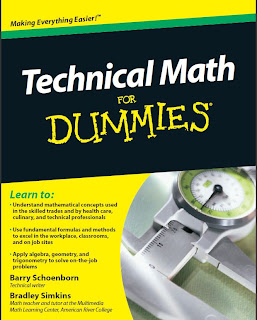Writer: Barry Schoenborn
&
Bradley Simkins
Published Year: 2010
Publisher: Wiley Publishing, Inc.
ISBN: 978-0-470-59874-0
Page: 388 Pages( Origonal Print)
Size: 10 MB (rar)
Technical Math For Dummies applies basic math to basic tasks in many careers. You get practical examples, and most of them are based on real-life experiences. And in what other book can you work with math and also find out how to make 90 dozen pralines or figure the distance from a fire watch tower to a wildfire? You can also apply a lot of this math to your personal life as well as your work life.
Part I: Basic Math, Basic Tools
In this part, you get math basics (and we do mean basics). Chapter 1 gives you an overview of broad technical math concepts. Chapter 2 dispels myths about math and provides some history about technical careers. Technical professions are very old and go back (at least) to making arrowheads and spear points. And with all due respect to art history and library science majors, stonemasons built the pyramids.
You also learn about the tools of the trades in this chapter. The remaining chapters in this part are a complete review of basics — numbers, addition, subtraction, multiplication, division, measurement, and conversion. You see how to do these operations faster and better. We also tackle something that everybody says fills them with fear and loathing — the notorious word or story problem. Story problems can be filled with tricks and traps, but in this chapter you see how easily you can deal with them all.
Part II: Making Non-Basic Math Simple and Easy
In Part II, you review the workhorses of technical math, the processes that are a simple step above arithmetic. Most careers can’t function without them.
Part III: Basic Algebra, Geometry, and Trigonometry
You may think some topics (algebra, geometry, and trigonometry) are tough, but in this part you find out that they aren’t. The basic techniques are easy to understand, and those are the techniques you need. Now that’s a happy coincidence!
This part removes the mystery from formulas and shows you how to make your own custom formulas. It’s also filled with practical applications for areas, perimeters, and volume, as well as a little theory.
Part IV: Math for the Business of Your Work
In Part IV, we point out the obvious: “Life math” is different from “classroom math.” Although the previous parts have direct application to your technical work, this part brings some math concepts to the business side of your job. nIn this part, you see how to use graphs and charts to your advantage for both problem solving and presenting information to management and clients.
We also present a chapter on time math, which we hope clears up a few mysteries about the basic questions “What time is it?” and “How long will it take?”
The last chapter deals with computer math, and it’s a simple mini-education in what’s going on with your computer and your Internet connection. This chapter may help make you a smarter shopper when you’re buying computers, smartphones, MP3 players, and digital instruments for your business or your home.
Part V: The Part of Tens
For Dummies books always have a Part of Tens, and this book is no exception. The world loves lists of ten things, and in these chapters you find a large amount of information in a small space. Chapter 20 has ten principles for solving any common math problem. Its partner is Chapter 21, which contains the ten most commonly used formulas. It also has some formula variations and some estimating shortcuts. Finally, Chapter 22 shows you ten easy ways to get good at math while doing everyday tasks. Finally, we also include a glossary of terms that you may or may not see in the text but that may pop up in your work.


0 comments:
Post a Comment
Please leave post related comments